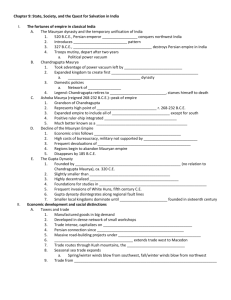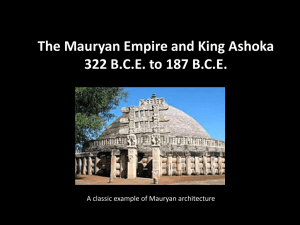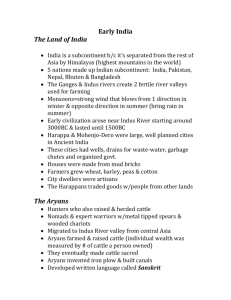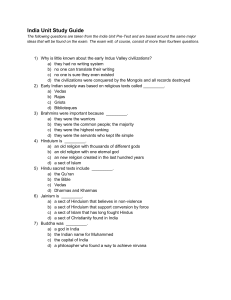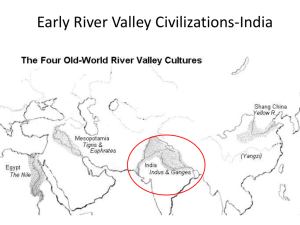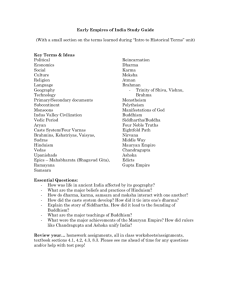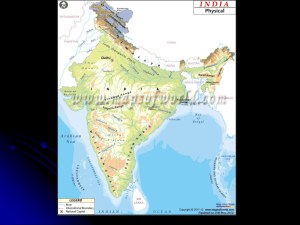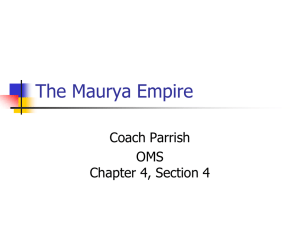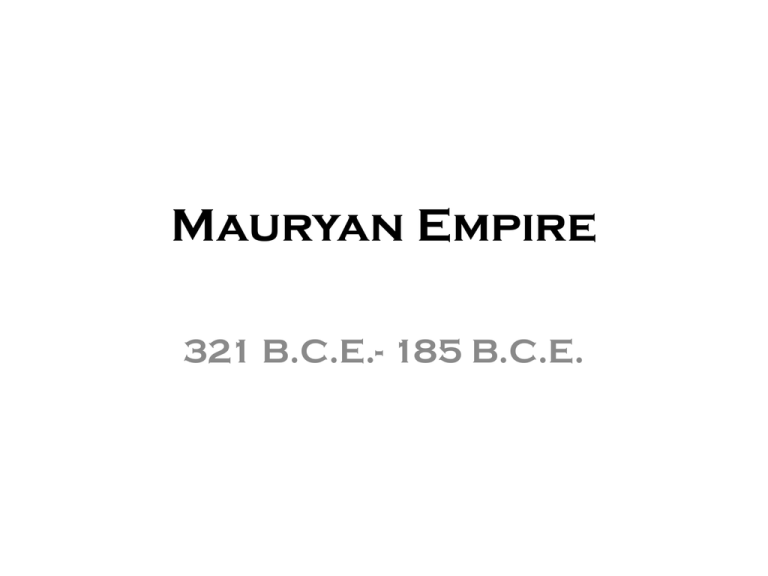
Mauryan Empire
321 B.C.E.- 185 B.C.E.
The Mauryan Empire 321-180 BCE
The Maurya Dynasty
With the Magadha state in decline,
Chandragupta Maurya seized power from the
last ruler of Magadha
Chandragupta would
expand the remnants
of Magadha to the Bay
of Bengal and the Hindu
Kush Mountains
The Maurya Empire was
the largest yet seen in India
Chandragupta Maurya
Politics
• Founded by Chandragupta Maurya ( 324
to 301 B.C.)
• Increased centralized govt control over
regional kingdoms
• large army of 700,000
• secret police to watch for treason
• 301 BCE gave up his throne to &
became a Jain monk (extreme
Buddhism)
Main Idea 1:
The Mauryan Empire unified most of India.
Starting around 320 BC Candragupta Maurya founded the
Maurya Empire.
Candragupta Maurya used an army of mercenaries, or hired
soldiers, to seize control of the entire northern part of India.
The strongest of all the Mauryan emperors was Candragupta’s
grandson, Asoka.
The Mauryan Empire lasted for about 150 years. In 184 BC the
last Mauryan king was killed and India divided into small states
again.
CHANDRA GUPTA MAURYA
( 321 BCE TO 297 BCE)
BINDUSARA
(297 BCE TO 272 BCE)
ASOKA PIYADASI (BELOVED OF GODS)
(273-BCE TO 232 BCE)
BRIHADRATHA (THE LAST MAURYAN KING)
(194-187 BCE)
THE MAURYAS: CHRONOLOGY
THE MAURYAN EMPIRE – 324 BCE
• Leaders depended upon the support of the army
• After its collapse, India was plagued by invasions from the
Himalayas in the northwest
• Chandragupta Maurya
•
•
•
•
First ruler to unify much of the Indian subcontinent
Had a large army
Established large bureaucracy
Autocratic ruler
CLASSICAL INDIAN POLITICS
Architecture in the
Barabar Mounts
The Mauryan Empire
• It is 324 BC. Chandragupta pushed the
Macedonian garrissons in Punjab and
Sindh out of India.
• Afterwards he attacked the kingdom of
Magadha that controls the Ganges and
conquered it.
• His mighty army, that he used to conquer
the Northern half of the subcontinent, was
composed of infantry, cavalry, war
elephants and chariots
Chandragupta: 321 BCE298 BCE
Unified northern India.
Defeated the Persian
general Seleucus.
Divided his empire into
provinces, then districts
for tax assessments and law
enforcement.
He feared assassination [like Saddam
Hussein] food tasters, slept in different
rooms, etc.
301 BCE gave up his throne & became
a Jain.
Chandragupta: 321 BCE-298 BCE
•Divided his empire into
provinces, then districts
for tax assessments and law
enforcement. Familiar?
He feared assassination food tasters,
slept in different rooms, etc.
Like Persia and China, a bureaucratic
administrative system enabled him to
implement policies throughout the state
Coinage, trade, tribute, etc.
The Maurya Dynasty
• Chandragupta established his court
at Pataliputra, on the Ganges River
• Fearful to leave the palace at
Pataliputra, Chandragupta and his
successors split the empire into many
provinces, each to be overseen by
local governors
• The governors would regulate tax
collection, justice, transportation, and
defence in their respective province
Centralized
Large staff
Tax collection, trade and
commerce, vital
statistics, welfare of
foreigners, maintaining
public places
Organized army
Provinces
Districts
Villages
The Mauryan Empire is Established
• Chandragupta Maurya Seizes
Power
– In 321 B.C. Chandragupta
Maurya seizes power, starts
Mauryan Empire
• Chandragupta Maurya Unifies
North India
– Chandragupta defeats
Seleucus I; north India is
united for the first time
– Chandragupta uses taxes to
support his large army
The Mauryan Empire
Many small kingdoms existed across India in 300s BC
Each kingdom had own ruler; no central authority
united them
Magadha a dominant kingdom near Ganges
– Strong leader, Chandragupta Maurya gained
control
– Began conquering surrounding kingdoms
– Conquests led to founding of Mauryan empire
The Mauryan Empire is Established
• Running the Empire
– Chandragupta’s chief adviser is Kautilya, a priest
– Chandragupta creates a bureaucratic government
– He divides the government to make it easier to
rule
The Mauryan Empire
• Under Chandragupta's rule trade
flourished.
• The treasury was filled and the
capital Pataliputra was one of the
biggest and most beautiful cities in
the world.
• Chandragupta used his wealth to
build up a large governing body.
Patna
•
•
•
•
•
•
•
Mauryan capital city
on the Ganges river
500,000 residents
largest city in the world during that era
surrounded by timber wall with 570 towers
wall was about 21 miles
Patna covered about 9 miles and was
surrounded by a moat
Political Profile
•
•
•
•
•
•
•
Political Centralization
Entire empire ruled by a powerful state
Maintained order with army and officials
Hands-on rulers
Claimed ¼ to ½ of all agricultural production
Heavily taxing
Created the universal emperor, a divinely
sanctioned leader with a special role in the
cosmic scheme of things
Kautilya
Chandragupta’s advisor.
Brahmin caste.
Wrote The Treatise on
Material Gain or the
Arthashastra.
A guide for the king and his ministers:
Supports royal power.
The great evil in society is anarchy.
Therefore, a single authority is
needed to employ force when
necessary!
POLITICAL IDEOLOGY OF THE
MAURYAS
• The political ideology of the Mauryas was
basically derived from the Arthashastra, the
treatise on government, is said to have been
written by the prime minister of Chandragupta
Maurya.
• Although often compared to Machiavelli's
Prince because of its sometimes ruthless
approach to practical politics, Kautilya's work
is far more varied--and entertaining--than
usual accounts of it indicates.
KAUTILYA’S PRAGMATISM
• Kautilya prescribed four principles of
conquest: Sam, the primary principle, implies
the use of rationalization but if this technique
does not work then the second element is Kam
i.e. bribery.
• If this does not produce the desired result, then
the tertiary principle is Dand or the vehement
use of violence.
KAUTILYA’S PRAGMATISM
• If all three fail then
the last machination
is Bheet or sowing
seeds of dissension
and discord.
KAUTILYA’S PRAGMATISM
• Arthashastra remains unique in all of Indian
literature because of its total absence of
specious reasoning, or its unabashed advocacy
of realpolitik.
• Espionage and the liberal use of provocative
agents is recommended on a large scale.
• Murder and false accusations were to be used
by a king's secret agents without any thoughts
to morals or ethics..
Arthashasta
• Espionage system was the fundamental aspect
of the Mauryan administration.
• Arthashastra advocates the frequent use of
spies, and recommends that they should work
in the guise of recluses, householders,
merchants, ascetics, students, mendicants,
women, and prostitutes.
Rise of the Mauryan Empire
Alexander the Great
Alexander’s legacy
• Alexander conquered force in
northwest India, 326 BC
• Alexander’s conquest inspired
Chandragupta Maurya
• Did not remain in India long
• Seized throne of kingdom of
Magadha, 321 BC
• Battle-weary soldiers wanted to
return home, soon left India
Mauryan army
• Chandragupta built immense
army, 60,000 soldiers
• Began Mauryan empire
Extended empire
• Defeated Seleucus I, 305 BC
• Chariots, war elephants
• Mauryan empire controlled
northern India, 303 BC
• Began conquering northern
India
• Also controlled much of what is
now Afghanistan
Government---Centralizing
• The nucleus of the Mauryan empire was the
king,
• and the increasing power of the king was
accompanied by a similar increase in the
power of the chief priest (purohita), who by
now had begun to assume the function of the
chief minister, his religious status receded in
the background (example: Kautilya).
Government
• The two key central officials were the
Treasurer and the Chief Collector.
• The treasurer was responsible for keeping the
account of the income in cash and for storing
the income in kind.
• The chief collector, assisted by a body of
clerks, kept records of taxes which came from
various parts of the empire.
Mauryan Rule
Strong government
Like Qin, Han rulers, Chandragupta Maurya established centralized
government to control empire, crush resistance
Relied on brilliant adviser Kautilya, Brahmin, member of the priest caste
Arthasastra
Manual for statecraft, thought to be written by Kautilya
Arthasastra called for strict state control
Also called for use of spies, even assassination
Empire divided
Chandragupta divided empire into districts, appointed loyalists to rule them
Organized bureaucracy ran government, spies monitored officials, gathered
information, rooted out threats to state
Government
• The Mauryan empire was divided into four
provinces each under a prince or a member of
the royal family.
• Governors administrating smaller units were
selected from amongst the local people.
• Each province was sub-divided into districts,
each of these into groups of villages, and the
final unit of administration was the village.
Government
• The urban centres had their own hierarchy of officers.
• Megesthenes describes the administration of
Pataliputra (capital) in detail.
• According to him, the city was run by 30 officials,
divided into 6 committees of 5
• Each committee supervised one of the following
functions: questions relating to industrial arts, matters
relating to trade and commerce, law and order,
welfare of the foreigners, supervision of the public
sale of manufactured goods and collection of tax on
articles sold (the tax was one tenth of the purchase
price).
The Mauryan Empire
Megasthenes
Pataliputra
• Greek ambassador visited
Mauryan Empire during
Chandragupta’s reign
• Greatest city, Mauryan
capital: magnificent
palaces, temples, parks
• Wrote about his
observations
• Government controlled
economy
• Described land of
prosperity
• Emperor owned land, rent
money from farmers
funded government
The Mauryan Empire
• Just like the first ruler of united China one
century later, the first Emperor of this new
Empire had a very important advisor.
• His name was Kautilya. According to his
teachings, the state should control
everything.
• Therefore, the Empire was full of spies.
• However, there also was tolerance towards
private enterprising and there was great
local autonomy, bounded by the rules of
the state. And, even the monarch had his
duties.
The Mauryan Empire
• In 305 Seleukos Nikator invaded the
Punjab.
• It is not known whether there had been
battle or not, but it is certain that
Chandragupta kept the Punjab and
annexed three of the richest provinces of
Seleukos.
• Also, the border was moved to the western
side of the Hindu Kush.
• The young Empire was secured.
The Mauryan Empire
• At a higher age, Chandragupta got
interested in religion.
• According to the Jainistic tradition,
Chandragupta left his throne to his
son Bindusara in 301 BC and slowly
hungered himself to death in a
Jainistic monestry.
Succession
• Tradition holds that Chandragupta
abdicated his throne to become a monk
and eventually starved himself to death.
• Whether this is true or not, it is certain that
his son, Bindusara, succeeded him
• In 297 B.C.E., added most of southern India
to the growing empire.
• The high point of the Mauryan Empire
came during the reign of Chandragupta’s
grandson, Asoka.
The Mauryan Empire is Established
• Life in the City and the
Country
– A Greek ambassador writes
glowing praise of the empire
– Chandragupta’s son rules
from 301 to 269 B.C., (32
years)
– Aŝoka—Chandragupta’s
grandson, brings the empire
to its height
Mahabodhi Temple, site of first temple built
by Asoka (3rd century B.C.) on spot of
Buddha’s enlightenment. Bihar, India
Ashoka Maurya
Asoka’s reign
(268-232 B.C.E.)
• Asoka’s first major
undertaking was to
conquer a region of eastcentral India known as
Kalinga.
• By Asoka’s estimate
100,000 died and over
150,000 were removed
from their lands.
• Some scholars debate
that because of the
bloody campaign, Asoka
converted to Buddhism.
Asoka
Asoka was the best known Mauryan emperor, ruling
from 269 to 232 BC
Under his rule, the empire
would reach its greatest size
During the conquest of
Southern India, a massacre
of more than 100,000
people occured
Feeling great remorse for
the deaths, Asoka renounced
violence and converted to Buddhism
Rule under Ashoka
Chandragupta gave up throne, 301 BC, became Jainist monk
Son became emperor, followed by grandson Ashoka
Mauryan empire reached height under Ashoka
Through warfare empire expanded, included most of India
Kalinga campaign
Violence of fighting at Kalinga appalled Ashoka
Abandoned policy of conquest and converted to Buddhism
Began to promote, spread policy of right conduct, Buddhism
Supported Buddhist missionaries, worked to improve lives of his
people
Ashoka 268-232 BC
•
Most important ruler in ancient India
•
Brutal military commander who extended the
Empire throughout S. and E. India
Battle of Kalinga - 260 BC
– 100,000 Kalingans died
– 150,000 Kalingans driven from their home
•
– More died from disease & starvation in the
aftermath of the destruction brought on by the
war
•
“What have I done?”
•
Ashoka and many Indian leaders converted to
Buddhism after this battle and became pacifists
•
He spent the rest of his life encouraging nonviolence, moderation and Buddhist principles to
India
ASOKA’S DHAMMA
• The people of the Mauryan empire needed a
common perspective to face all the divergent
forces; the power of mercantile community,
the influence of urban guilds, the strain of
centralized political system, the multiplicity of
races, cultures and languages in the empire.
• The adoption of a new faith and its active
propagation acted as a cementing force.
ASOKA’S DHAMMA
• Asoka did not regard himself as a Great Elect
in his relations with his subjects, but rather a
father figure.
• “ All men are my children, and just as I
desire for my children that they should
obtain welfare and happiness, both in this
world and the next, so do I desire (the same)
for all men.”
ASOKAS’ DHAMMA
• A centralized monarchy demanded more
dependence on the part of the population.
• The monarch is now regarded as the paternal
benefactor and not as the servant of the state.
• Asoka’s dhamma was his own invention and in
essence an attempt to suggest a way of life
which was both practical, and convenient, as
well as highly moral.
ASOKA’S DHAMMA
• The policy of Dhamma was the exposition of
his personal relationship with Buddhism and
his role as the emperor of the Mauryan empire.
• He used certain aspects of Buddhism to further
his own ideas, thus treating this religion not
merely a religious philosophy but also as a
social and intellectual force upon society.
• The Edicts gave him the opportunity to
expound his dhamma to its fullest context.
Asoka
•
•
•
•
•
•
Asoka was a famous ruler of India. He became
emperor in 268 BC.
After fighting a bloody battle, he sickened of
war and turned his life in a different direction.
He became a Buddhist, or someone who
followed the teachings of Buddha
. He lived peacefully and built roads for
travelers, planted trees to give shade,
constructed rest houses and dug wells.
He considered all his subjects his children and
tried to care for them with love and kindness.
Many people became Buddhist after Asoka’s
example.
Asoka
• As a Buddhist, Asoka began preaching the virtues of
good work, nonviolence, and religious tolerance
• Stoopahs were built for monks throughout the
empire and roads repaired, so that pilgramages could
be made to religious shrines
• Asoka spread Buddhism to Southeast Asia and
modern day Sri Lanka by dispatching missionaries
throughout the region
A Stoopah in the Mauryan Capital of Pataliputra
• Asoka: The Buddhist
King of India
– Buddhism turned Asoka,
the bloodthirsty king of
ancient India’s Mauryan
Empire, into a peaceloving ruler.
Asoka’s Buddhist
Rock and Pillar Edicts
spread Buddhist principles
scattered in more than 30 places
in India, Nepal,Pakistan, &
Afghanistan.
Each pillar is 40’-50’ high.
helped bring order and unity to
India
One of
Asoka’s
Stupas
Asoka (304 – 232 BCE)
Religious conversion
after the gruesome
battle of Kalinga in
262 BCE.
Dedicated his life to
Buddhism.
Built extensive roads.
Conflict how to balance Kautilya’s
methods of keeping power
and Buddha’s demands to
become a selfless person?
Asoka’s law code
Edicts scattered in
more than 30 places
in India, Nepal,
Pakistan, & Afghanistan.
Written mostly in
Sanskrit, but one was in
Greek and Aramaic.
10 rock edicts.
Each pillar [stupa] is 40’-50’ high.
Buddhist principles dominate his laws.
ROCK INSCRIPTION: GIRNAR
ROCK EDICTS # 1
• PROHIBITION OF • Arthashastra has
ANIMAL
listed the killing of
SACRIFICES AND
animals as an
FESTIVE
inviolable punishable
GATHERINGS
act. And Asoka’s
order was the
continuation of the
same policy.
ROCK EDICT # 2
• MEASURES OF
SOCIAL
• WELFARE
• It is interesting to
note that these
measures facilitated
• Medical centres for men
trade, commerce and
and animals.
communications, and
• Construction of roads
and highways.
were recommended
in Arthashastra.
• Plantation of trees and
herbs on the roads.
ROCK EDICT # 3 &4
• There was lack of
• SHOWING
civility
and
morality
RESPECT TO
in the empire by
BRAHMANAS
showing disrespect
AND SHRAMANAS
to Brahmans, and
relatives, killings of
IS A VIRTUE
the animals and other
forms of immoral
practices.
ROCK EDICT #5
• INSTITUTION OF
DHAMMAMAHAMATTAS
• The special cadre of
officials were
appointed by Asoka
who were directly
responsible for the
practical working of
Dhamma.
• A centralized
administration
• is always more
efficient if social
welfare at all levels
is well attended to
and Asoka’s
centralization
included the welfare
of his subjects.
ROCK EDICT # 6
• THE MAHAMAHATTAS ARE
TOLD TO REPORT
TO THE KING ANY
TIME
• The availability of the
king was regarded as an
important characteristic
of a good monarch and
was stressed in
• all theoretical sources.
• Arthashastra prescribes
this in his chapter on
Duties of the Kings.
• Megesthenes’s
statement about
Chandra Gupta that he
attended the matters of
state while being
massaged and giving
audiences.
ROCK EDICT # 7, 8, 9 & 10
• PLEADING FOR
VALUE OF
TOLERENCE FOR • THE
PRACTISED
ALL SECTS
CEREMONIES IS
QUESTIONED AND
ATTACKED
• DESCRIPTION OF
• ASOKA
SYSTEM OF
DENOUNCES FAME
DHAMMAAND GLORY AND
YATRAS
DESIRES THAT HIS
SUBJECTS SHOULD
FOLLOW THE
DHAMMA
EDICT # 11 & 12
• CONQUEST BY
DHAMMA
• The idea of conquest
through Dhamma is a
logical development of
the theory of Dhamma.
It is opposed to
conquest by force and
thus eliminates
aggressive warfare. The
use of term conquest
implies the adoption of
these principles.
• DESCRIPTION OF
EDICTS BEING
INSCRIBED
THROUGHOUT THE
EMPIRE
• Asoka Dhamma was
promulgated to
consolidate the
achievements of his
ancestors and to fulfill
his moral obligations
and to achieve an
unparallel place in the
annals of history
.
The Mauryan Empire is Established
• Asoka Promotes Buddhism
– After a bloody war with Kalinga, Asoka promotes
Buddhism and peace
– Preaches religious toleration—accepting people of
different religions
– Builds roads, with wells along them
Ashoka's column
Ashoka's column
The best preserved of the pillars
that King Ashoka erected in about
240 B.C.E. is this one in the Bihar
region, near Nepal.
The solid shaft of polished
sandstone rises 32 feet in the air.
It weighs about 50 tons, making
its erection a remarkable feat of
engineering.
Like other Ashokan pillars, it is
inscribed with accounts of
Ashoka's political achievements
and instructions to his subjects on
proper behavior.
These pillars are the earliest
extant examples of Indian writing
and a major historical source for
the Mauryan period. (Borromeo/Art
Resource, NY)
63
Copyright © Houghton Mifflin Company. All rights reserved.
Religion
• Buddhism grows
• built thousands of Stupas for
Buddhist followers.
• built Buddhist schools and
universities
• the unnecessary eating of animals
was abolished.
• Wildlife became protected
including the first national parks in
the world
• promoted vegetarianism and built
animal hospitals.
• Ashoka’s empire died out slowly
after he died
• Sent Buddhist missionaries to neighboring lands
• India became a major crossroads in a vast
trade network
• Mauryan Empire declined after his death
Asoka’s Buddhist proselytism
Architecture
•
•
•
•
Pillars
Lion Capital of Asoka
Stupas
Barabar Caves
Economy
• Controlled Khyber Pass
• Trade with Greece, Hellenistic Kingdoms and
Malaysian Peninsula
Trade/Economy
Agricultural economy
•New canals and irrigation systems for trade and agriculture.
•renovated major roads throughout India.
•built towns for spinning & weaving textiles
•uniform system of currency, weights and measures
•Created provinces ruled by governors for tax assessments and law enforcement
•Taxes rose over time to build Ashoka’s projects which led to Empire’s fall at
Ashoka’s death
•Increased trade by uniting India
•India traded silk, cotton, and spices to Mesopotamia, China, Egypt and Rome
Trade
• Mauryan prosperity
• Highways fostered commerce
-east-west highway
• Merchant quarters
• Active exchange with adjacent countries
Indian Agriculture
• State farms
operated and
cultivated by
slaves.
Grew Rice, Pepper,
Wheat, Barley,
Mustard, Sugar
Cane, Medicinal
Roots
Social Systems
•
•
•
•
Extended family smallest social unit
High-point for women in ancient India
Some slavery
Very little use of caste system
Asoka
’s
Empir
e
Turmoil & a power
Vacuum:
220 BCE – 320 CE
The Maurya Empire is divided into many kingdoms.
The Mauryan Empire
Mauryan empire began to decline following death of Ashoka,
232 BC
Sons battled for power, central control weakened
Distant provinces began to slip away
Last Mauryan emperor killed by one of generals, 184 BC
Mauryan empire lasted 140 years, then collapsed
The Mauryan Empire
• 324 Chandragupta drives the
Macedonian grassisons away
• 305 Seleukos Nicator invades,
Chandragupta gains 3 provinces and
the Empire is secured
• 301 Bindusara becomes Emperor
• 269 Ashoka becomes Emperor
• 232 Ashoka dies, decline begins
• 184 The Empire collapses
A Period of Turmoil
• The Breakup of the Mauryan Empire
– Asoka dies in 232 B.C.; kingdoms in central India
soon break away
– The Andhra Dynasty dominates central India for
centuries
– Northern India receives immigrants from Greece
and other parts of Asia
– Tamils—a people living in southern India—remain
separate and frequently war with rival peoples.
After the Mauryans:
Regional Rule and the Rise of Jainism
and Buddhism
Jainism – like Hindu and Buddhism
• Believe in karma, dharma and Moksha
• expected to follow five principles of living:
• Ahimsa: "non violence in all parts of a person -mental, verbal and physical."
• Satya: speaking truth; avoiding falsehood
• Asteya: to not steal from others
• Brahma-charya: (soul conduct); remaining sexually
monogamous to one's spouse only
• Aparigraha: detach from people, places and
material things. Avoiding the collection of excessive
material possessions, abstaining from overindulgence, restricting one's needs,
Regional Kingdoms and local rule - 185
BCE to CE 300
• Northern India
– Invading HUNS built new small regional
kingdoms
• Hindu Kush civilizations
– Most powerful regional kingdoms for trade
across the region and along the Silk Road
• Jainism grew in influence during this time of
confusion since the leaders pushing Hindu
and Buddhism were weakened

